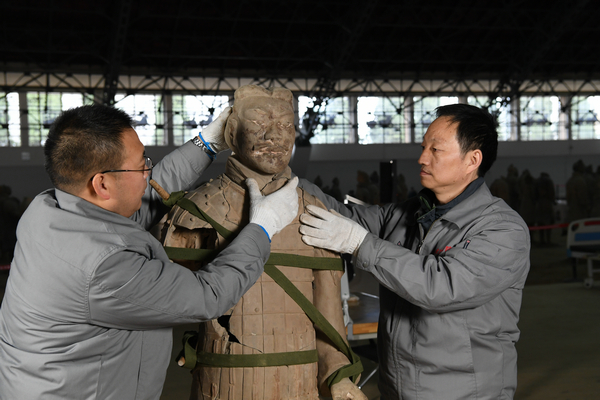 |
|
Lan Desheng (right) and his colleague Wang Dongfeng restore a Terracotta Warrior. ZHANG TIANZHU/FOR CHINA DAILY |
The ideal job
During the past 25 years, as a researcher with the Emperor Qinshihuang's Mausoleum Site Museum, Lan has restored more than 150 of the figures.
He mostly lives a routine life. The museum is on the eastern outskirts of Xi'an, about 50 kilometers from the downtown area, while Lan lives on the southern side of the ancient city.
At 7 am every work day, he takes a shuttle bus from his home to the museum, leaving the No 1 pit at about 5 pm for the return journey.
He said he was anxious when he first started work in this field, even though it was his ideal job.
In 1993, Lan graduated from Northwest University in Xi'an with a major in cultural heritage, and three years later, he started work on restoring Terracotta Warriors.
The conservator-restorers face a strict training program. In the first two years, Lan was not allowed to touch the relics and was told to "observe, remember and read".
His first task after his training ended was to locate fragments and search for missing parts of the figures among the piled shards.
Sometimes, he was unable to find a single missing piece, and often asked his instructor when he could start to repair a complete Terracotta Warrior. He did not have to wait long.
Now, walking along the No 2 pit, which contains figures of the warriors and their horses, Lan proudly points to them and states, "I repaired two of these pieces."
The technology used to restore the figures has changed over the years, but the fundamental methods remain the same.
After fragments of the warriors and horses are collected, the restorers attempt to piece them together before using glue to bind them.
Over the decades, the restorers have become accustomed to delays and the fact that hardly anything can be done immediately. Patience is essential.
Lan, who approaches his work with passion and excitement, set up a special operations table at the No 1 pit. Sets of repair tools, including magnifying glasses, brushes and surgical knives, are placed on the table.
Like his wife, an ophthalmologist at a major hospital in Xi'an, Lan has a special set of tools he uses to clean and repair the figures. After a period of study in Germany, he even returned home with scalpels.
"They are extremely sharp and useful for restoration work," he said. However, as he spoke, he bent one of the surgical knives.